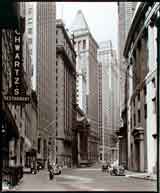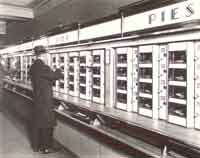Marriage and More (Click most images for larger versions.)
Saturday, September 29, 1934, at 10 a.m. Bud and I exchanged vows.
It was at 10:00 a.m. on Father P.J. Moyers performed the ceremoney at St. Augustine's Church in Brooklyn, on the corner of Sixth Avenue and Park Place. The reception was at 11:00 a.m. in Little's, a restaurant on the corner of Prospect Place and Flatbush Avenue, less than two blocks from the church. I remember floating as Bud and I walked down the street with everyone for the reception meal and dancing. It was a very special day for us.
Ike and Mother remained cool, still not enamored of Bud, but willing to let me go, sure it would all come to a bad end. I don't think Ollie felt much different, but Robert Alan was all smiles, laughing, joking, and mostly drinking. But, nothing could spoil my mood that day. That day a new world opened its doors and I was going through gladly, ecstatically.
For our honeymoon, Bud and I spent ten days of wedded bliss at Phillip's West Side Mountain Lake, in Pawling, New York. The weather was sunny but cool; a perfect Fall honeymoon. I still have pictures of us in a row boat on the lake and sitting on a rustic bridge beside the lake. Being a city girl, I can also remember how excited I was to discover turtles in the creek that passed under the bridge, but Bud wouldn't catch one for me to keep as a pet. I knew he was right, but they were my first real live turtles.
Our first apartment was at 290 Lincoln Place in Brooklyn, less than a mile from home, and cost $45.00 a month. Our first "home!" The furnishings weren't much, but we managed, and would say, half-jokingly, that all we really needed was a good bed. I remember how wonderful it was to look out our rear windows at Prospect Park, visible because no building was behind us. We looked right across the street to the park. Also, we were within walking distance of the Brooklyn Museum of Art, the Brooklyn Botanic Gardens, and our parents' homes. We were very happy there, but two years later we jumped at the chance to move into a lovely little apartment in Astoria, an area now called Long Island City or L.I.C.
One of the reasons we moved was so Bud wouldn't have such a long commute, but then my work transferred me to Lower Manhattan, so I wound up with the long commute. The apartment was close to a subway station, however, so it wasn't too bad. The fact that the apartment was new helped me to deal with my travel time—neither one of us had ever lived anywhere new.
The apartment was on the second floor of a four-story building, and it was not a cold water, railroad flat. It was a "modern" apartment, meaning you entered through a foyer, not through the kitchen. From the foyer, you went directly into the living room and from there into the kitchen or bedroom. It also had hot, running water and all the modern appliances—bliss! Behind the building was a private tennis court, which was another of our reasons for moving—we liked to play tennis.
I remember being very happy in our "new" apartment.
I made the commute to the Met until I took a summer off—working in the New York heat and humidity was never high on my list. Then, in the fall, I went to work for Dictograph Products up on 5th Avenue and 48th Street, so I wouldn't have to commute so far. But, the following summer I took off again—I liked taking those months off.
 And that next fall, I got a job with Bankers Trust on Wall Street and worked there until we left for California.
And that next fall, I got a job with Bankers Trust on Wall Street and worked there until we left for California.
One of the memories I still carry from that Bankers Trust period involves Trinity Church, a New York landmark where many famous people are interred. The church stood at the head of Wall Street, just up from Bankers Trust, and I took my lunch breaks there. I would go in for the solitude, the warmth in Winter or the cool in Summer, and for the noon organ recitals. The music lifted my spirits, and took me back to the joy of my classical music introduction—the Brooklyn Museum and "Sheherazade." It provided a complete break from the bustling city and the pressures of work. I would go back refreshed.
(My life after "Sheherazade" is dotted with vivid memories either caused by or scripted to classical works. One took place in the apartment of my dear friend, Pan Sterling.)
Pan and I met while working at Bankers Trust, and she was wonderful: literate, curious, full of life. We went to symphonies together, shared our secret thoughts, and struggled with our new corporate existence. She was also a writer and, later, became widely published and fairly wealthy. I still have copies of some of her magazine articles, mostly fiction.
Anyway, I have a very vivid memory of lying on the floor of her apartment in Greenwich Village, with broken sun slicing through the partially closed blinds, and listening to Prokofiev's, "Love for Three Oranges." The record player sat on the floor near my head, vibrations coming up through my body as well as through my ears. And the music soared. It flooded up and over me and washed through the whole room. It engulfed me. I floated on the sound, my mind expanding with it, until I couldn't tell where the room began and I stopped. It was a wonderful out of body experience.
 Speaking of Pan and Manhattan, there are other memories: places we went, things we did. I remember free concerts and music appreciation classes at the New York School of Music. Afterwards, the hot fudge sundaes, or the apple pie with cheddar cheese, and the crisp, white tablecloths at Schraffts. We loved dining at any of the many Horn and Hardart's Automats. I especially liked their chocolate cream pie—I still love chocolate cream pie! The Automats were such fun. Their novel combination of fast-food, vending machines, and cafeteria-style eating were a big hit. It saddened me to hear that the last one closed in April, 1991. Of course, my choice of favorite foods was a harbinger of the infamous sweet tooth in my family.
Speaking of Pan and Manhattan, there are other memories: places we went, things we did. I remember free concerts and music appreciation classes at the New York School of Music. Afterwards, the hot fudge sundaes, or the apple pie with cheddar cheese, and the crisp, white tablecloths at Schraffts. We loved dining at any of the many Horn and Hardart's Automats. I especially liked their chocolate cream pie—I still love chocolate cream pie! The Automats were such fun. Their novel combination of fast-food, vending machines, and cafeteria-style eating were a big hit. It saddened me to hear that the last one closed in April, 1991. Of course, my choice of favorite foods was a harbinger of the infamous sweet tooth in my family.
As for other memories from my early married days, I loved Bud sending telegrams to me.
I also remember going to lots of parks and beaches and company resorts. Back in those days, companies had resorts or retreats for employees to visit on weekends. We would go with other employees and take friends and meet lots of people. There would be fun things to do, like costume contests and holiday parades. At one of those resorts, thanks to Bud, I also went on my first snipe hunt.
Being a city girl, I didn't know anything about country life, so when Bud and some of the others began talking about a snipe hunt, I was interested. That night we all took gunny sacks out into the woods and they placed me, all alone, in a strategic spot—so they said. The idea was to hold the sack open, then call and whistle to the snipe until they ran into it. What did I know? After five minutes in the dark, I started thinking of what might be in the woods besides snipe. After ten minutes, I was cold and scared. Not much later I called out to the others, but no one answered. That freaked me out, so I decided to go back without them—silly me.
It was dark, and I had to thrash my way around before finding the path. I was nearly hysterical when I finally found my way back to the resort and my highly amused "friends." Everyone thought it was hilarious, except me. I was furious, mostly at Bud for leaving me like that. I survived, but it revealed a darker side to his mean streak.
Mean streak or no, we survived three years of married life in the City. Then in 1937, Bud and I went to see Janet Gaynor and Frederic March in a movie called, "A Star is Born." It was going home from the theater that we decided, suddenly, to move to California. We tied up loose ends at our jobs; stowed as much as we could fit into our nearly new, royal blue, Chevy roadster; put the rest of our belongings into storage; said goodbye to everyone we knew and loved; and then left for the Coast on a wintry New Year's Eve.